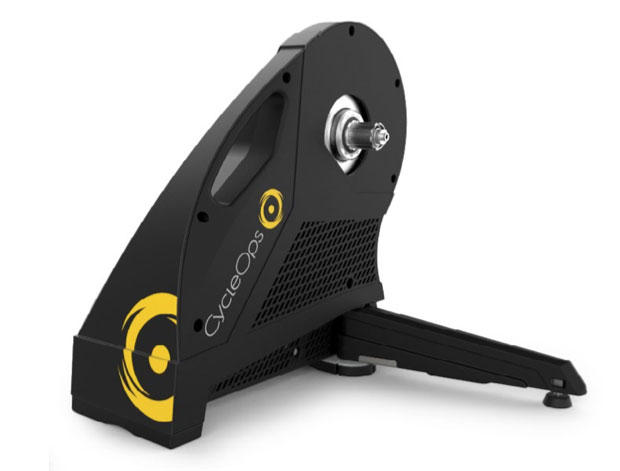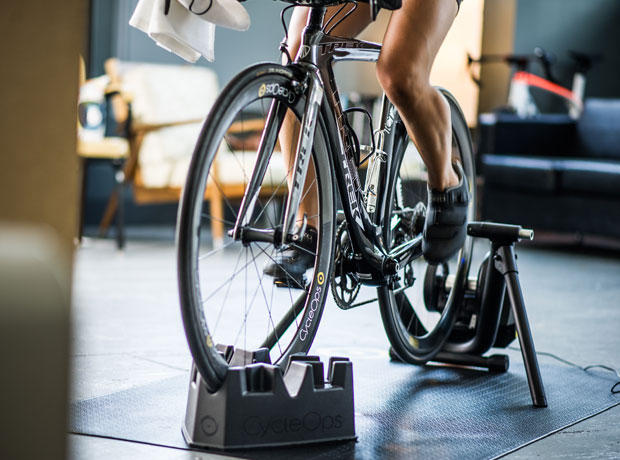Tacx NEO v Wahoo Kickr
Stationary training is getting more elaborate. And more expensive. But if anything in cycling needed a kick in the pants it was the experience of riding while going nowhere.
Direct drive (direct mount) trainers are front and center in the evolution of a better basement experience. There are several good products: The Elite Drivo, the CycleOps Hammer, and two we’ll profile here: The Tacx NEO and the Wahoo Kickr, which I will refer to as the Kickr 2.0 to differentiate the previous model.
Spec-wise these two pencil out similarly, with the NEO holding a slight edge in all or nearly all metrics. The Kickr 2.0 costs less, at about $1200 vs. NEO $1600 (without a cassette). Slowtwitch conducted extensive testing on each of these.
Specifications
The new Kickr looks like its predecessor. The obvious outward difference, right off, is a much-improved carrying handle. Otherwise, the most recent prior version of the Kickr was well done, I had few complaints, explaining why there are not many updates to this model.
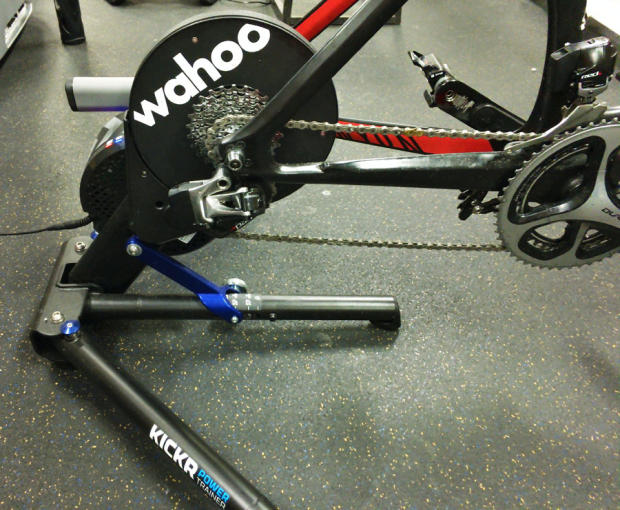
But there are some upgrades to the Kickr 2.0, such as improved accuracy (+/- 2%), LED connection lights, a claimed 14% reduction in sound, the maximum incline increased to 20%, and improved feel or sensitivity to virtual platforms.
Along with the above improvements, users still get nearly universal compatibility with road and time-trial bikes, an 11-speed cassette, a Wahoo RPM, along with the ability to pair the Kickr to third-party power meters (the Wahoo Kickr can sync to the bike’s on-board power meter), and a maximum resistance of at least 2000 watts.
The NEO exceeds virtually all the specifications of the Kickr. The NEO claims a greater power accuracy of 1%, greater maximum incline of 25%, and a maximum wattage of 2200 Watts, and although not expressing the noise the trainer makes in decibels, the Neo boasts being the quietest trainer on the market.
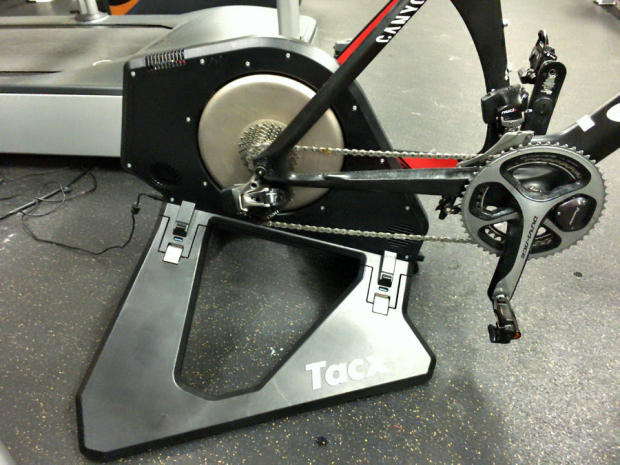
Along with the above differences, there are few other subtle differences that can get overlooked. The NEO does not require a power source to operate unless you want trainer control features; it doesn’t require calibration; and it can simulate downhills and different types of road surfaces such as cobblestones when used with virtual platforms such as Zwift. The NEO’s execution of this is very impressive.
Compatibility
Both the Kickr 2.0 and the Tacx NEO are compatible with all the major platforms (e.g. Zwift, TrainerRoad, Sufferfest) and nearly every other software or mobile application on the market today. They both use Ant+ FEC and Bluetooth Smart allowing third-party apps, mobile devices, and virtual software programs to control either trainer. Of note, unlike Wahoo, Tacx has its own platform of virtual rides and training available for purchase, Windows only (a little more on this below).
Both trainers also have connectivity lights to indicate when peripheral devices are connected via Ant+ or BTLE, a minor but nice feature. The Kickr 2.0 and NEO can also re-broadcast data in both Ant+ and BTLE including speed, cadence, and power.
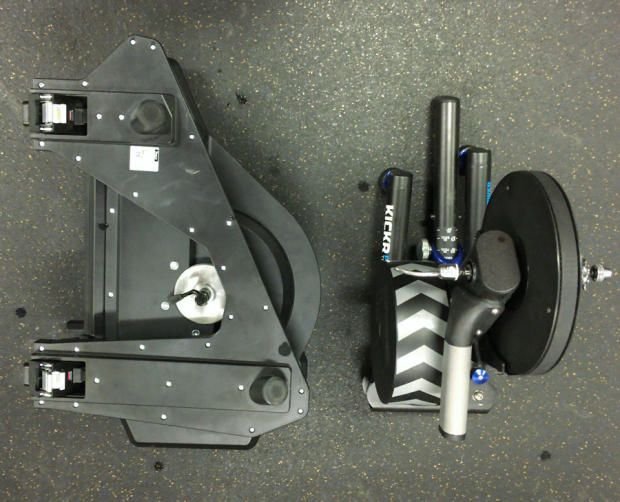
While both trainers should be compatible with almost all bikes, the NEO did have some issues with certain TT frames, and there has been a running change. Prior to purchasing a NEO for a TT style bike, confirm with the retailer if “W2017” is on the serial number as found here on the Tacx support page. Also, there is a very active Facebook Group found here for Tacx Neo Owners that I recommend to any current or prospective owners.
Sound, Accuracy, and Feel
Direct drive smart trainers tend to be the quietest and most accurate trainers, and better replicate road feel versus their wheel-on counterparts. Sound and accuracy are easy to quantify and compare but feel is subjective.
The Kickr 2.0 boasts an accuracy of +/- 2% while the Neo lists as +/- 1%. To put that in comparison, the P1 pedals I used to compare report a +/-1.5% error rate and my Pioneer power crank based power meter is +/-2%, so, the Kickr 2.0 and NEO are within error bands of some of the top performing power meters. My testing has them consistently within a couple of watts of P1 pedals at various intervals and in my testing I could not find that one distinguishes itself above the other in accuracy.
Which of these trainers is quieter? I tested the Tacx NEO and Kickr 2.0 riding at approximately 200 Watts, at 20mph, and 75-80 rpm on a freshly lubed drivetrain. The ambient noise was 48 db in the room. The Tacx NEO averaged 57db while the Kickr 2.0 averaged 61db. The difference seems more significant due to the different frequency of sound made by the Kickr 2.0 vs the NEO. There is also less floor vibration with the NEO compared the Kickr 2.0. These features may explain why the NEO seems to be quieter than the Kickr 2.0. Testing on different flooring might yield a different result.
In comparing the Kickr 2.0 and the NEO, there is a palpable difference in road feel. With the NEO the overall feel while pedaling is smoother. Ascending and descending feels a bit more natural with the NEO, as well as the feel-the-road features offered by virtual platforms, Zwift inclusive.
Practical Considerations
Sometimes, buyers overvalue minute differences in the specs in competing devices and undervalue what is realistic or practical. As a tech editor I’ve been guilty of this. Will you or I notice the difference between 1.5% or 2.0% error rate? Is the fact that a trainer peaks at 2000 watts instead of 2200 relevant? Can users perceive a 4db difference between a pair of trainers?
Some considerations are more practical. I learned that my basement floor, where I station my indoor trainer, is not level. Were it not for my ineptitude as a carpenter I likely would have failed to appreciate the importance of the adjustable legs on the Kicrk2, a feature not on the Tacx NEO.
Likewise, the NEO is a device you don’t want to drag around. It is heavy, bulky, and there is no easy way to carry it. It folds into a nice low-profile design (a pic of both trainers folded up is above), but it is a stay-put trainer. Because Wahoo made that big improvement to its handle it is the only smart trainer I bring to someone else’s PainCave for a workout.
On the flip side, the Tacx NEO is without question the most stable trainer I have tested. Also, it feels the softest on a carbon frame, somewhat due to its wide foot platform but more importantly that softness is a result of four hinges on that Neo providing just enough give during hard efforts.
Lastly, as more devices move towards ecosystems, or integration, buyers need to consider how their current devices might interact with their new devices, such as a smart trainer. The BSX Insight will not control the Tacx NEO during a BSX lactate test, but it does function with the Kickr 2.0. The Wahoo Elemnt was designed to work with the Kickr and Kickr 2.0, and does so in amazing fashion. Owning a Wahoo Elemnt might be a deciding factor between Kickr 2.0 and Tacx NEO.
Conclusion
Direct drive smart trainers are more refined than they were, slightly more accurate, slightly (or more than slightly) quieter, and somewhat less expensive. Certainly, the Kickr 2.0 and Tacx NEO both meet the needs of any cyclist and are among best-in-category. The Kickr 2.0 is a clear value winner, and also gets the nod for users of BSX Insight and Wahoo Elemnt. If I regularly transported my direct drive trainer the Kickr would be it. I can suffer transporting the NEO occasionally, but not regularly.
While the NEO costs an extra $400 (plus the cost of a cassette) it’s more stable, it offers a better feel and features for virtual rides, and it is marginally quieter. The NEO is a better choice for larger or more powerful riders.
Beyond the scope of this overview is the software trainer companies provide, but, the suite of options Tacx provides are probably underappreciated and certainly underreported (at least here on Slowtwitch). Its Films (above is a 1-minute promo video) are terrific fun and take full advantage of the NEO’s road-feel.


